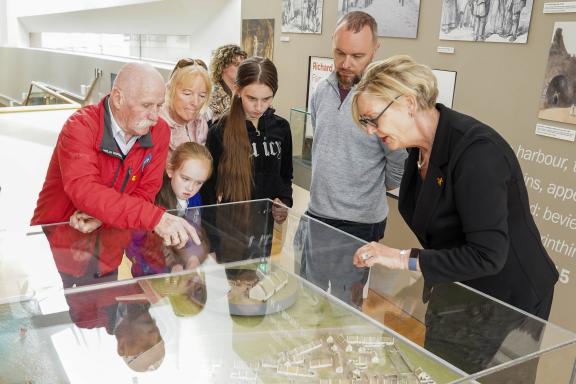
Galway City Museum is delighted to receive a collection of objects from local man Tommy Holohan. These objects belonged to Tommy’s grandmother Nan (Anne) O’Toole, a fishwife, and his grandfather, Michael O’Toole, a Claddagh fisherman, who lived with their family in a cottage at Rope Walk, Claddagh, Galway.
The collection includes Nan’s prayer book, three ceramic jugs and a birdcage – many of the fishermen in the Claddagh kept small birds such as linnets or goldfinches.
The Claddagh was a small village of thatched houses located outside the medieval town walls, which was occupied by Irish-speaking fishermen and their families and headed by an elected king. In 1927, the village was declared ‘unhealthy’ due to overcrowded conditions and a lack of ‘sanitary accommodation or water supply’. The Town Commissioners decided to demolish and rebuild the Claddagh. The British journalist and travel writer H. V. Morton (1892-1979), who visited the village on the eve of its demise, declared: “The Claddagh of Galway is one of the most remarkable sights in Europe”. Nonetheless, the thatched homes were gradually razed to the ground and replaced by rows of two-storied houses.
Anne (Nan) Conneely was born in Rope Walk, Claddagh in 1877 and married local fisherman, Michael O’Toole in 1897. They had six daughters, one son and twins who died in infancy. Together, they reared their family at Rope Walk, with Nan selling the fish brought in by Michael at the corner of Eglington St., directly across from where Brown Thomas stands today.
In 1913, Nan became the subject of some of the first ever colour images of life in Ireland. Two French ladies, Marguerite Mespoulet and Madeleine Mignon-Alba photographed Nan with her daughter Mary as part of a project funded by Musée Albert Kahn in Paris, an ethnographic museum, to document disappearing cultures around the world and to create an Archive of the Planet.
In her life, Nan was renowned by the Claddagh people as having cures for many ailments. For infants suffering with bowel problems Nan prescribed the dust from burnt turf and holy water to be added to their bottle at feeding time. Babies who were born prematurely were often hung in a fishing net over a basin of warm water which was said to replicate the womb, providing the greatest comfort for the child. Nan was also renowned for her cure of eye infections which involved licking the eye.
Michael O’Toole died in 1934 in the thatched cottage, and it’s understood that Nan moved to Grattan Road around 1935 or 1936. The cottage contents went with her. Nan O’Toole died in 1952.
On a recent visit to the Museum with family members, Tommy Holohan had this to say:
“As Nan O Toole’s grandson, I am delighted to gift to Galway City Museum the contents of her thatch house at Rope Walk, Claddagh, Galway. To me, as a Claddagh man, it is very important to preserve our Claddagh culture and heritage”. He added further that “the contents of Nan’s cottage” as far as he was aware “are the only known contents of a Claddagh cottage that survive and must be preserved for future”. The objects now form part of the Galway City Museum collection and thanks to Tommy and the Holohan family they can be enjoyed by the people of Galway for many years to come.
Visitors to the Galway City Museum can see Nan O'Toole's objects up close as the collection is currently on display in the Galway Hooker exhibition. Admission to the Museum is free and opening times are Tuesday to Saturday, 10am - 5pm and Sunday, 12pm - 5pm (until September).
[Photo: Boyd Challenger]